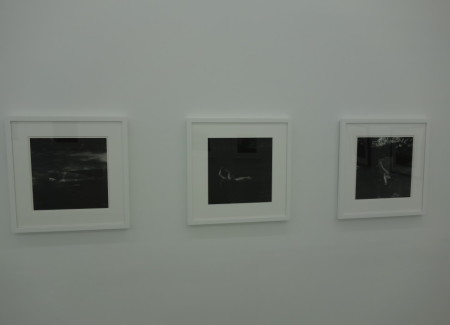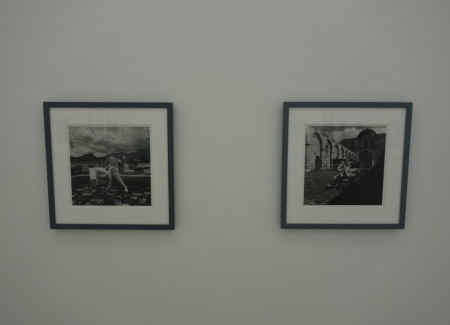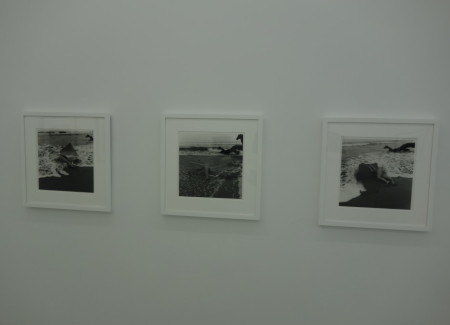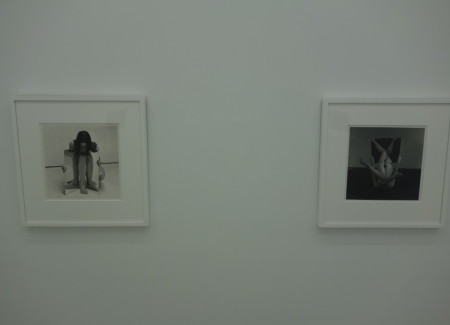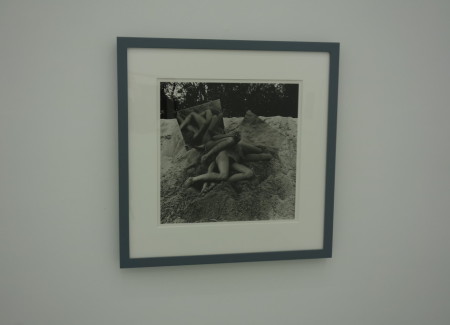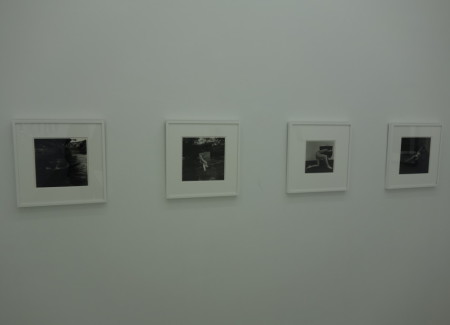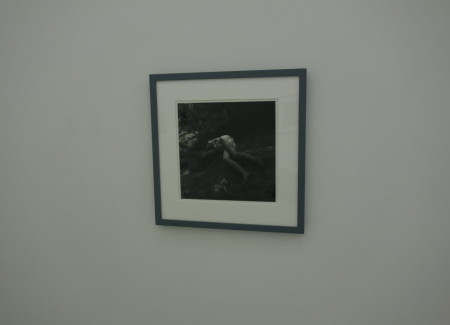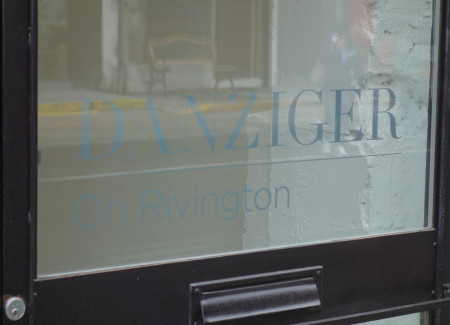JTF (just the facts): A total of 22 black and white photographs, alternately framed in grey/white and matted, and hung against white walls in the two room divided gallery space. All of the works are gelatin silver prints, made between 1970 and 1973. Physical sizes are either 11×14, 16×20, or 24×24, and the works are either unique or available in editions of 2, 3, 4, 5, 7, or 8. A small catalog has been produced as part of the exhibit, with essays by Philippe Garner and James Danziger. Note that the gallery has moved locations from Chelsea to the Lower East Side. (Installation shots below.)
Comments/Context: One of the most exciting results of the rediscoveries that disrupt the photography world now and again is that the arrival of these new entrants almost always catalyzes an open process of art historical re-evaluation and re-ordering. In the case of artists like Vivian Maier and Mike Disfarmer (among many others of late), these re-introductions consistently lead us to active discussion (and controversy), as we collectively work to intellectually wedge a heretofore unknown participant back into a previously accepted chronology of relationships and influences. New information, in the form of these rediscovered careers, begets a new look at history, and the rewriting that occurs as a consequence infuses the canon with fresh energy.
In the case of Hans Breder’s distorted female nudes from the period of 1969 to 1973, sliding these recently rediscovered works back into the historical record is actually quite easy. On one hand, Breder’s nudes follow along in a progression of distortion and abstraction of the human form that holds as its high points André Kertész and his carnival mirror and later Bill Brandt and his high contrast isolations. What’s perhaps more tantalizing about these pictures is that they also include a skew set of aesthetic ideas coming in from the worlds of late 1960s/early 1970s performance and land art, with a dash of emphasis on the sculptural qualities of form in three dimensions. It’s almost as if we can hear the click as Breder’s photographs snap right into place, as a missing link between lines of artistic thinking that were previously largely separate.
While the works on view in this show span only a handful of years, there are actually three distinct phases of imagery to consider. Breder’s experiments began in the controlled confines of his studio, with a single model and the sparse furnishings of a chair and the bare floor. While Kertész’s use of the mirror was largely off camera and Brandt’s was only intermittent (and for the most part straightforward), Breder brought the mirror into the composition itself, as an intertwined element held by the model. Here the mirror acts as both a reflector and interrupter, doubling some body parts while obscuring others, the angle of reflection creating unexpected combinations; it’s not so much that the form has been distorted into surreal oddity, it’s that the body has been wholly reorganized, with simultaneous views from opposing sides combined into a single unexpectedly sculptural whole. Legs triple and quadruple, torsos flip and repeat, and stately curves go places they normally don’t, each one a gracefully deliberate exercise in formal illogic.
A year later, Breder took this mirror approach outside, dropping his nude model in a slow moving river and situating her (or two models in a few cases) on the sandy riverbanks. While the principles of reflection are the same, from the bisected bodies to the doubled arms, the tone of the pictures is entirely different – they are less like controlled studies, and more akin to active interventions. There is a sense of the models being caught in motion, in the midst of interacting with the natural surroundings, performing as it were, with the mirrors confounding the single point perspective. The mirror is more obviously out of place in these pristine environments, breaking up nature into Cubist-style fragments (just like Robert Smithson did in the Yucatan). The nudes are no longer sculptural in isolation, but integrated into the larger scope of the landscape. This was an aesthetic idea that Ana Mendieta would take further in subsequent years.
Breder kept pushing on the mirror concept in 1973, this time placing his models (again sometimes more than one) on rooftops, in stone buildings and courtyards, and on the Mexican seashore in the frothy waves. In these works, the performative aspect of the stagings is amplified even further, the shards of bodies interacting with both the nearby architecture (a technique employed later by Francesca Woodman) and the ebb and flow of water. The best of these compositions use the mirror(s) to not only abstract and double the available arms and legs, but to also redirect the forces of nature, bringing the sky into the center of the frame (interrupting the edge of a stone wall or a row of columns) or twisting the waves into impossible combinations of momentum.
More than most photographers of the nude, Breder had a sense for the sculptural qualities of bodies, where knees, arms, and hips were arranged in the richness of space rather than being considered as a set of photographically flattened lines. His disorienting forms never fall toward the grotesque – even when limbs multiply in inhuman angles, the effect is nearly always thoughtfully graceful rather than boldly shocking. And his mirrors give us the impression of being able to walk around inside his pictures, taking in the forms from changing depths and perspectives. Seen together, Breder’s short flurry of photographic activity bore quite a bit of durably innovative fruit. These are nudes full of formal vitality, challenging in their construction and elegant in their execution.
Collector’s POV: The works in this show are priced as follows. The 11×14 prints are $9000 each. The 16×20 prints range in price from $10000 to $60000 each. The 24×24 print is $35000. Breder’s work has little secondary market history, so gallery retail remains the best option for those collectors interested in following up.

